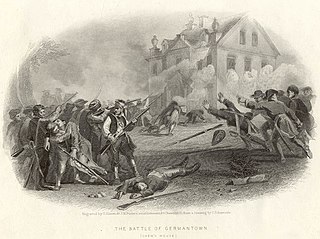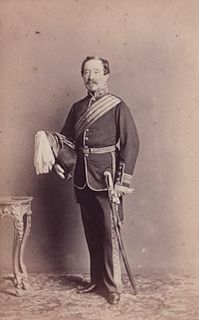
Lieutenant-General Sir Henry William Stisted,, served as the first Lieutenant Governor of Ontario after Confederation, from 1867 to 1868.
Peter Grant VC was a British Army soldier and an Irish recipient of the Victoria Cross, the highest award for gallantry in the face of the enemy that can be awarded to British and Commonwealth forces.

General Lord George Henry Lennox was a British Army officer and politician who sat in the House of Commons from 1761 to 1790.

The 44th Regiment of Foot was an infantry regiment in the British Army, raised in 1741. Under the Childers Reforms it amalgamated with the 56th Regiment of Foot to form the Essex Regiment in 1881.
General Sir William Keppel GCB was a British soldier and colonial administrator.
The 91st Regiment of Foot was a Line Regiment of the British Army, raised in 1794. Under the Childers Reforms it amalgamated with the 93rd Regiment of Foot to form the Argyll and Sutherland Highlanders in 1881.
The 93rd Regiment of Foot was a Line Infantry Regiment of the British Army, raised in 1799. Under the Childers Reforms, it amalgamated with the 91st Regiment of Foot to form the Argyll and Sutherland Highlanders.
The 123rd Regiment of Foot was an infantry regiment of the British Army, formed in 1762 and disbanded in 1764. Its colonel was John Pomeroy.
The 100th Regiment of Foot, or the Loyal Lincolnshire Regiment, was an infantry regiment of the British Army, formed in 1780 and disbanded in 1785. The Loyal Lincolnshire Regiment was reformed in 1794 as the 123rd Regiment of Foot and was again disbanded in 1796.

Lieutenant General Sir Jasper Nicolls KCB was Commander-in-Chief, India.
Lieutenant-General James Montgomerie was a Scottish soldier and politician who sat in Parliament for Ayrshire 1818–29.

General William Wemyss of Wemyss was a Scottish soldier in the British Army and Member of Parliament.

The Battle of Germantown on 4 October 1777 pitted a 9,000-man British army under General William Howe, 5th Viscount Howe against an 11,000-strong American army commanded by General George Washington. After an initial advance, the American reserve allowed itself to be diverted by 120 English soldiers holding out in the Benjamin Chew House. A heavy morning fog disoriented the American assault columns and led to a friendly fire incident between elements of Major General John Sullivan's right column and Major General Nathanael Greene's left column. At about this time, the American attack lost impetus and both columns retreated. Meanwhile, two wide flanking columns numbering 3,000 American militia had little effect on the outcome. American losses was numbered at 673 soldiers killed and wounded plus 400 captured, while the British suffered 520 casualties.

General Freeman Murray CB was a British Army officer who became General Officer Commanding Eastern District.
The 103rd Regiment of Foot was a line infantry unit of the British Army. Though only existing for just over 10 years, the regiment would see more action than most of its 100-series regiments.
The 103rd Regiment of Foot was a British Army regiment raised in Bristol in May 1794. The regiment was raised by Lieutenant-Colonel William Dyott. Initially known as the Loyal Bristol Regiment, it was renumbered as the 103rd Regiment of Foot later that year but disbanded the following year when personnel were transferred to the 4th Regiment of Foot and the 7th Regiment of Foot.
The 103rd Regiment of Foot was a British Army regiment formed at Bury St Edmunds in October 1760. It took part, alongside the Royal Marines, in the Capture of Belle Île in April 1761 during the Seven Years' War. It was then disbanded in England in 1763.
The 72nd Regiment of Foot was a regiment in the British Army from 1758 to 1763.
The 92nd Regiment of Foot was a short-lived infantry regiment in the British Army which was raised in 1779 to provide garrison troops for the West Indies during the American Revolutionary War.
The 83rd Regiment of Foot (1757–1763) was a short-lived infantry regiment in the British Army which was raised in Ireland in 1757 to counter the Spanish Invasion of Portugal of 1762, an offshoot of the Seven Years' War.






